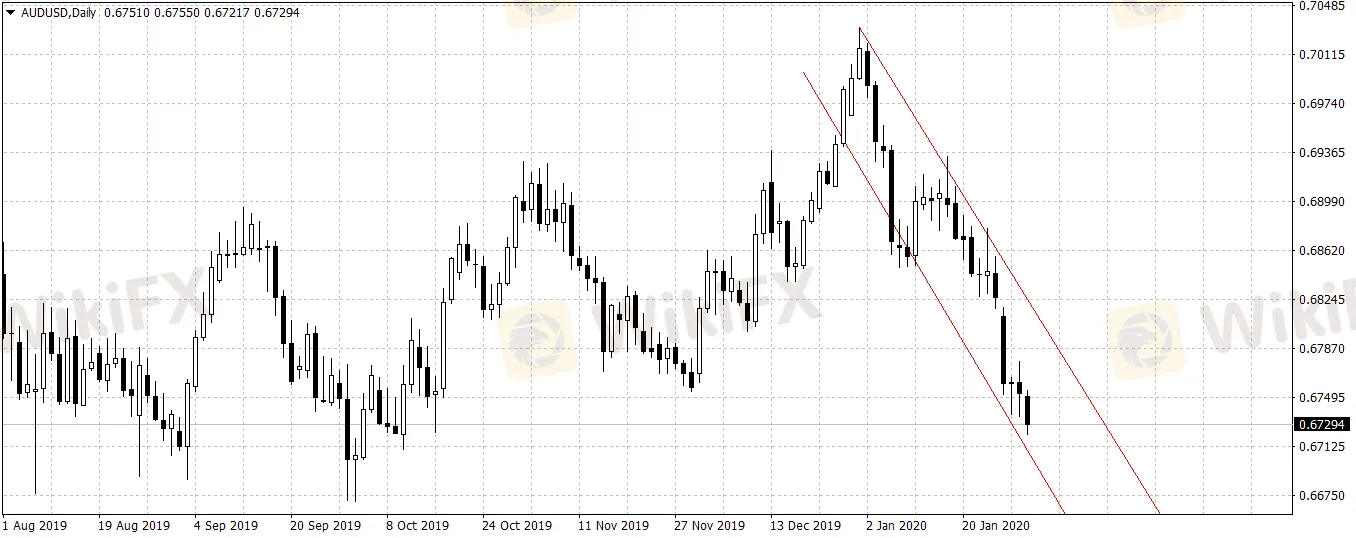简体中文
繁體中文
English
Pусский
日本語
ภาษาไทย
Tiếng Việt
Bahasa Indonesia
Español
हिन्दी
Filippiiniläinen
Français
Deutsch
Português
Türkçe
한국어
العربية
AUD’s Trend Is Affected by Macro Economy
Abstract:Latest statistics show Australia’s annualized CPI from Q4, 2019 to be 1.8%, lower than the central bank’s 2%-3% long term target range, which the inflation fails to reach ever since 2017.
Latest statistics show Australia‘s annualized CPI from Q4, 2019 to be 1.8%, lower than the central bank’s 2%-3% long term target range, which the inflation fails to reach ever since 2017.
A worrying fact is that, like the core inflation elsewhere around the globe, Australia‘s average inflation excluding items facing price volatility remains at 1.6%, and has been hovering at that level for 5 quarters, which may explain why the Australian dollar’s response to the data was lower than expected.
Moreover, the beginning of 2020 has been an awful start for the overall economy. The raging epidemic of novel coronavirus has been a hard blow on Australian dollar which is linked to economic growth. Amid a wave of risk aversion, the market is worrying about possible impact of the coronavirus epidemic on tourism and economy of the Asia Pacific region.
Global economy remains nearly stagnant in an international context full of uncertainties, while global central banks still lack efficient financial stimulus. Even if the Reserve Bank of Australian decides not to cut interest rate next month, the AUD will be hard to climb against all these adversaries. The daily average chart suggests AUD/USD has fallen to the lowest point since the end of 2019.
AUD/USD daily pivot points: 0.6754---0.6756
S1: 0.6733 R1: 0.6775
S2: 0.6713 R2: 0.6797

Disclaimer:
The views in this article only represent the author's personal views, and do not constitute investment advice on this platform. This platform does not guarantee the accuracy, completeness and timeliness of the information in the article, and will not be liable for any loss caused by the use of or reliance on the information in the article.
Read more

What Will EU Lose After Brexit?
Britain has officially left the European Union on January 31st , 2020, and will soon start negotiations with the European Union regarding bilateral relations in the future. It is believed that Brexit will cause negative impacts on the European Union in multiple aspects.

What Do the Economic Indicators Say About GBP
British general election at the end of 2019 was conducted against a sluggish economy. Latest statistics show that Britain’s economy growth is stagnant and the once strong labor market has weakened. In the first half of 2020, the pound will need to navigate through the domestic economy, central bank policies and the crucial March budget. In addition, the Brexit negotiation is still in its preliminary stage, whether a free trade agreement can be successfully concluded will also be critical.

CAD Will Have Less Upward Momentum in the New Year
As the G10 currency that performed the best in 2019, Canadian dollar may see a rather smooth horizontal trend this year partly because weakening domestic economy, and partly because the positive influence of easing trade tensions has been fading. CAD rose 5% against the USD in 2019, with nearly half of the increase gained in the last few weeks, benefiting as several other currencies from a reduce of risk factors at the end of 2019.

Aussie Faces Weak Demands Both Home and Abroad
Australian economy appeared sluggish in 2019. Stagnant wage growth and debts piling up have made consumers significantly reduced their spending, and though Reserve Bank of Australia had lowered the interest rate by 0.75% through 3 rate-slashes, private consumption remained low.
WikiFX Broker
Latest News
AIMS Broker Review
The Hidden Checklist: Five Unconventional Steps to Vet Your Broker
YAMARKETS' Jingle Bells Christmas Offer!
Doo Financial Expands Regulatory Reach with Offshore Licenses in BVI and Cayman Islands
Why is there so much exposure against PrimeX Capital?
Russia to Fully Ban Crypto Mining in 10 Regions Starting January 1, 2025
MTrading’s 2025 "Welcome Bonus" is Here
Doo Financial Obtains Licenses in BVI and Cayman Islands
CFI’s New Initiative Aims to Promote Transparency in Trading
Currency Calculator


